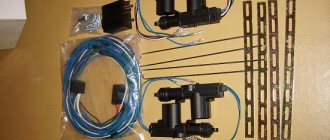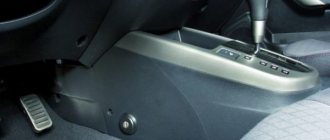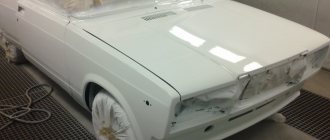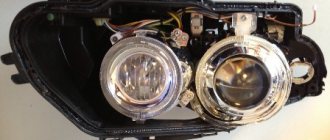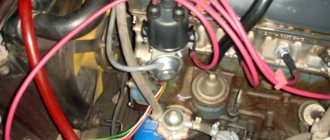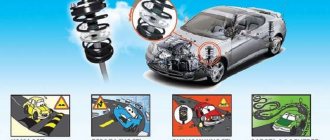Often, owners of VAZ products have to remind their passengers that the door can only be closed if they slam it quite hard. And, unfortunately, both the front door and the back door close this way. It is difficult to imagine a VAZ-2107 car owner, or any other model, who would not want to correct such a defect. In this article we will show you how to find a way out of such a predicament, using silent car locks that are installed on more modern models, for example, on the VAZ-2114 or VAZ-2115. And since installing silent locks on a VAZ-2107 does not require special skills, every car owner can easily cope with this task if he performs the work step by step.
Design disadvantages of VAZ door locks
Over the 40 years of operation of the VAZ 2101-2106 and 2105-2107 door locks, no significant deficiencies in its design have been identified, and with appropriate care, which consists of periodic lubrication and cleaning of the mechanism, the locks fully meet even the most stringent requirements for reliability and safety, as has been stated repeatedly Tested for burglary and strength in critical situations.
A rattle when closing the door indicates incorrect adjustments of the VAZ door lock and insufficiently thorough maintenance of their mechanism. Noise when closing can occur primarily when the latch and locking bolt wear out, when wear leads to distortion of the geometry of the mechanism, which is fully compensated by proper adjustment followed by washing and lubricating the entire locking mechanism. Once again, we emphasize that the locks are designed to last a lifetime, subject to timely maintenance.
Preparing to install locks
First, we purchase the treasured set of locks. You will need two sets, each with two locks. When choosing a manufacturer, pay attention to the fact that GAZ locks are the quietest option, but in this case you will have to file off the tongue. If we consider DAAZ, this is, of course, the noisiest option, but they can be improved. At the same time, the quality of construction and durability is one of the best. Well, the best option is silent locks for the VAZ 2110 Ptimash. In terms of silence, they are the most acceptable, and in terms of reliability, everything is fine with them.
Important! Before purchasing, be sure to carefully inspect the locks for defects. It is not recommended to purchase a set of locks with unclear manufacturer's name.
Set of silent locks
We prepare the necessary tools. For installation we will need:
- Hammer;
- Phillips and hex screwdriver;
- Drill;
- The castles themselves.
Lock installation
We start by carefully removing the old locks from all the doors. To do this, completely unscrew the top bolt. We do not remove the lower bolt completely, loosen it a little.
Dismantling the old castle
Now we slightly move the upper part of the lock and again install the bolt in this hole. Why are we doing this? In this case, we are considering the option of installation without removing the casing. If you follow the instructions exactly, you will save time on removing and re-stretching the trim. Thus, by reinserting the bolt, you prevent the lock located inside the door from falling down.
Everything else is logical. We remove the remaining bolt, dismantle the lock, and install a new one using the same scheme.
Final point. All we have to do is remove the old bolt holding the lock on the door and install a new one.
Replacing the old bolt with a new one
Now you can check the result of your work. The same must be done with the remaining doors.
In principle, we can stop there. If you are satisfied with everything and the result is what you expected, then congratulations. However, if something doesn’t suit you, or you want a greater effect, adjusting the VAZ 2110 door lock will help you.
Installing central locking
Continuing to modernize and improve your “swallow”, you may be interested in installing a central lock on the VAZ 2110. There is no need to argue about the advantages of such an option. Poking around with a key in a rusty, frozen lock is not a pleasant pleasure. And we must not forget about protection against theft. Therefore, we purchase the treasured box, in which we will find:
- 4 engines, one of which is installed on the driver's door;
- Control block;
- Wires, fuses and strips.
Central lock kit
Next, we collect the necessary tools: screwdrivers, drill, electrical tape, etc.
We remove all the elements that interfere with us, such as trim and panels, and mainly decide where we will install the control unit. The driver's door, its lower left corner, is rightfully considered the best place. This choice of location will allow you to subsequently install window lifters or other systems without any problems.
To install the engines, we need special holes in the door. If there are none, then we make them using a drill. And we move on to installing the engines.
Central locking installation process
Let’s not forget that each of them has 2 outputs. And only one - 4. It is located on the driver's door. After successful installation, you need to stretch the wiring. It should not be carried out where it may be exposed to moisture or other influences. It is advisable to protect the wiring, for example, with a corrugated tube.
After the installation of the VAZ 2110 central locking is completed, check the entire system. Now the central locking is controlled using the key fob that was included in the kit. If your version did not have it, then control occurs when you turn the driver's door key. In the future, if you wish, you can install a special control button on the dashboard.
Disadvantages of silent locks VAZ 2107
Special “silent” locks, unlike standard locks on VAZ 2108 or foreign cars that can be installed on “classics”, include plastic parts instead of metal ones. Plastic does not knock when the mechanism operates, but its strength and wear resistance are much lower than that of metal.
Some silent VAZ 2107 locks, made in a homemade way, have design flaws, for example, reduced thickness of the latch or other elements of the locking mechanism.
Using low-quality locks is dangerous - a weakened mechanism may not hold the door under load, for example, if a passenger leans on it during a sharp turn. Therefore, when choosing locks, you need to realistically evaluate their quality and, in the absence of special skills, install standard “eight” locks, which make little noise but have a fair margin of safety.
If you decide to install silent locks with plastic elements, you should understand the consequences of a possible malfunction.
Cleaning and lubricating standard locks gives an acceptable result, making the operation of the doors not completely silent, but quite comfortable.
Adjusting the mechanism
Having installed silent locks-2107 on a car, in order to fully use all the advantages of the mechanisms, you need to configure them correctly. Adjustment is carried out by moving the latch fixing bolt. First you need to let him go a little and close the door. It should fall into place. Then carefully open the door, being careful not to move the bolt. Next, you need to check the quality of the door latch. If it is not completely satisfactory, then you need to continue tuning. By releasing the bolt and moving it, it is necessary to achieve smooth operation of the mechanism. The door should close with minimal physical impact on it. By repeating the adjustment operation on all doors, you can enjoy the perfect operation of your car's locks.
Features of installing silent on VAZ 2105, 2106, 2107
One important feature should be taken into account when installing silent locks on “classic” locks. After installing the lock, the lever that is responsible for opening the lock is directed in the other direction, i.e. it must be lowered to open the lock, unlike the factory lock, where the lever had to be raised. This entails modifying the standard door opening handles or installing the euro handle upside down. An additional metal flag must be installed on the internal mechanism of the handle of the VAZ 2105 and 2106, to which the rod will be attached, so that when the handle is opened, the flag presses down.
Additionally, a flag is made that will push the rod down
The flag is installed on the handle on the side that is closest to the lock.
The flag is bolted into a pre-drilled, tapped hole
We recommend: What to do if a hernia appears on the wheel
When starting work, you should be guided by the principle “Measure twice, cut once”; here it will come in handy more than ever. Having done everything efficiently, you will get a good result. Now you don’t have to loudly slam the door, sometimes several times. New locks will ensure quiet and easy closing of the door, which will be especially noted by owners of foreign cars who enter the interior of your car. Despite the fact that the process of installing silent locks on a car is very painstaking, requiring both time and material costs, the result will please you for a very long time.
A car door lock is a part that usually requires almost no repairs, since it rarely fails. But, like other components of the car, it wears out, especially on the driver's door, since every time a person gets in or out of the car, the lock is activated. Over time, this leads to the fact that the door begins to close worse, in particular, you need to slam it harder for the lock to work, and sometimes it completely loses its functionality. This is especially evident on cars of outdated designs, such as classic VAZs. Therefore, in today’s article we will talk about replacing the front left door lock on a VAZ-2107.
Tools and materials:
- 2 screwdrivers – regular and Phillips;
- 10mm wrench;
- Felt pen;
- Lock lubricant;
- New castle.
A new part is sold in almost any auto store and costs about 300 rubles. The latch, internal handle and cylinder cost around 100 rubles. for 1 piece or even less. External handles will cost the most - about 400 rubles. for 1 piece However, everything together rarely changes; usually, we are talking about one of these details.
It is better to replace the lock in a spacious and bright room, like any other repair. Also keep in mind that the door trim clips are not very strong and must be removed with care.
Your Car Portal
Published on October 29, 2014 by Andrey in Auto Tips // 0 Comments
You can make silent locks yourself - this is a fairly effective method.
For this procedure you will need the following tools:
1. Motor oil.
2. Regular syringe.
3. Self-adhesive window seal (50 centimeters).
5. Impact screwdriver.
6. The bolts are silent.
To make the event more convenient, we will remove the locks from the doors (we still need to change the bolts). Using an impact screwdriver, remove the mounting bolts of this lock.
Having removed the mechanism, we do not close the door. In place of the old fasteners we will place a pin with an M8 thread. Then the lock fastenings will not “go” into the casing (or you still have to disassemble it).
Cut off the adhesive part of the seal from the bottom. Determine the required length in advance. Then carefully glue the places with pieces of sealant.
Be sure to lubricate the device with motor oil; this closing mechanism needs to be processed - a syringe is required here. You need to develop the lock, wipe it, remove all excess oil. Now we install the lock and return it to its place. We fasten the installation with new silent bolts and fix the components.
Remember that it is forbidden to remove the springs from the lock. They are the ones who can cause the door to open spontaneously.
Not everyone is ready to carry out such an operation, so you can simply buy ready-made sets of such silent locks, the set does not exceed 1 thousand rubles.
It would seem that, judging by the name, the “silent” locks on the VAZ 2110 should close quite quietly, but this was not the case: to achieve greater comfort, they also need to be modified. You can modify the silent locks of your VAZ 2110 in three ways:
What tools and components need to be prepared
Of course, you can install such locks in a car service center, but you will have to pay a lot for the service, and independent work will require a minimum of cash investments and very few tools and additional components:
- A set with external euro handles, it is best to give preference to a well-known manufacturer.
- Locking mechanism with latch.
- The part of the lock that is inserted inside the device is often called the “chocolate bar”.
- Two fixing bolts that fit VAZ-2114 or VAZ-2115 car locks. It is worth noting that such clamps can have both short and long sizes. Experts recommend choosing the longest fasteners.
- A connecting bolt for the rack and a tap with which you can cut the thread.
- A small cable, the diameter of which will be approximately 1.5-1.6 mm and drills measuring 8.5, as well as 9 and 10.
In addition, a drill and a hammer, as well as a set of screwdrivers and medium-sized sandpaper can be useful in the work.
How to replace the ignition switch, check the contact group and replace it on a VAZ 2108-VAZ 21099?
Replacing the ignition switch:
Removal: 1) Starting with “The battery is a rechargeable battery,” unscrew the nut that holds the “-” terminal on the battery and then remove the terminal. (How to remove the negative terminal from the battery, see the article about “Replacing the battery on a VAZ”, in the “first” paragraph)
2) Then remove the steering column cover and both steering column switches. (How to remove the casing and both switches, see the article: “Replacing under-steering switches”)
Further, for clarity, the operation will be shown with the steering wheel removed, but you can still remove the ignition switch without removing the steering wheel.
3) Next, insert if the lock allows it, then insert the ignition key into it and put it in position “0”.
Note! The key must be installed in this position only to disable the anti-theft device!
4) Now remove the four bolts that secure the ignition switch. If you have these bolts with a cut off head, then knock them down with a hammer and chisel
(Be sure to read the “Important!” paragraph)
Note! If that doesn’t work, then try drilling out all four bolts, but just do it carefully without damaging anything!
5) Once the bolts are loosened, use pliers to remove them from the hole.
6) Next, remove the bracket on the left side, and the ignition switch on the right.
7) Now disconnect the wire block from the electrical connector.
And finally, crawl under the dashboard, and there, disconnect the connector going from the ignition switch to the relay.
Installation: Installation of a new lock is carried out in the reverse order of removal.
Checking the contacts of the wire block:
1) First, remove the lock from the car using the text above.
2) Next, using an “Ohmmeter” or a “Multi-meter” with the “Ohmmeter” function enabled on it, connect its leads to the electrical connector and then look at the readings of the device.
Note! The device should clearly display “0”; otherwise, replace the contact group!
Replacing the contact group:
1) First, on the removed ignition switch, use a screwdriver to unscrew the screw that secures the ignition switch cover.
2) Then use a screwdriver to press out the two plastic latches securing the lock cover.
3) Then remove the cover.
4) And finally, remove the contact group from the ignition switch.
Note! Installation of the contact group is carried out in the reverse order!
Important! Not on all cars of the Samara family the ignition switch is attached to the steering column with four bolts; on some cars it is attached only with two bolts and on top it is secured with a hook indicated by a red arrow!
Additional video material: Below we have prepared a video related to replacing the ignition switch on cars of the Samara family.
Design and device of the VAZ 2107 door lock
The standard Fiat door mechanism was developed almost 50 years ago, and since then it has not undergone any special modifications. Maybe that's a good thing. Nevertheless, we have to put up with some relics of the past, and although there are much fewer complaints about the locking mechanism than about some other parts and components, it can be brought to a state of combat condition without making any special design changes.
The door lock of the classic VAZ 2107 serves to securely lock the door in two positions: closed, latched with one click, and closed, latched completely. Stock DAAZ locks are designed taking into account the emergency loads that the locking mechanism must withstand, keeping the door closed. To do this, the thickness, material and geometry of the latch, as well as the method of its fixation on the lock body, were calculated in a production laboratory.
Another equally important structural element of the VAZ door lock is the fixing bolt, which is screwed into the center pillar reinforcement and into the rear door opening reinforcement. The fixing bolts are made of durable steel and are also designed to securely fix the door when closed. The locks are controlled using metal rods, some of them have adjustable plastic tips. Despite the fact that the lock design is primitive, it is quite reliable and cannot be replaced for the entire service life of the car.
How to replace a lock
The design of the locks on the front and rear doors of the car is fundamentally the same, the difference lies in the installation of the lock switch cylinders on the external handles on the front doors. Instructions on how to replace the front door lock are presented below:
- The lower seal is pressed out, and three spring clips are removed from above to secure the protective film and one from below.
- The protective film is removed from the door.
- Inside the lock, the lock switch and external handle rods are disconnected.
Disconnection points for switch rods
Tip: During assembly, sealant was applied to the threads of the screws, so when twisting, you need to use an impact screwdriver.
- The outside door lock is removed.
- Unscrew the two screws securing the internal handle of the device.
- The handle is pushed inside the door.
- The internal lock and handle are pulled out of the doors, as shown in the photo.
The handle and lock are removed from the door
- The rubber holder is removed from the end of the rod.
- The handle is removed from the rod. In this case, it needs to be cranked.
- The locking bracket is detached from the lever pin.
- The rod of the internal handle is disconnected from the internal lock lever.
- The plastic holder is rotated and the end of the rod is removed from the lever to lock the device.
- Unscrew the two nuts securing the outer handle of the lock.
- The handle is removable.
- The plastic rod end is removed from the door lock cylinder and removed.
- The locking spring is removed. To do this, its ends are removed from the slots on the lock handle and cylinder.
Removing the retaining spring
- A key is inserted into the lock cylinder and the part is removed from the handle.
- Repairs and replacement of faulty elements are carried out, or a new lock is installed.
- Assembly of the unit occurs in the reverse order.
- The lock can be adjusted if necessary. To do this, loosen the screws and move the latch:
- outward, when the door is tightly closed;
- inward, if the door is not closed tightly;
- down if the door is raised when closing.
After adjusting the device, tighten the screws.
Tip: If you need to remove the retainer, you must first trace its outline on the body pillar. This will help maintain the door lock adjustment during installation.
How the door locks are removed on a VAZ 2109 car can be clearly seen in the video.
How to install a silent lock on the door of a VAZ 2109 car
Very often you can hear an unpleasant metallic clang when closing the doors of a VAZ 2109, especially in older models. This is due to the fact that the lock is attached to the outside of the door and when closing it comes into contact with the metal parts of the body and creates a characteristic sound. Manufacturers are now producing silent locks. They are sold in pairs, left and right, their price is reasonable. If the door lock on a VAZ 2109 car is jammed, it is better to immediately replace it with a silent one. To do this you need:
Unscrew the bolts holding the old lock on the car door.
Unscrewing the fixing bolts of the old lock
- The pin is screwed into place of the unscrewed bolt, otherwise the inside of the lock may fall inside the door.
- The old lock is removed and a silent one is installed.
- The bolts are tightened with maximum force. Tighten using an impact screwdriver.
- You can also install locking pins or silent bolts.
Installation of silent bolts
The installation operation ends with adjusting the locks. In this case, the position of the latch changes due to large holes in the rack. For this:
- The contours of the latch are outlined on the stand.
- When opening the doors tightly, you need to loosen the screws holding the latch, it moves outward and the screws are tightened.
- If the door does not close tightly, the latch must be moved inward.
- If the door lowers when closing, the latch must be raised and lowered when the door is raised.
Tip: In order not to disturb the adjustment of the clamp, you need to install a spacer made of waterproof sandpaper under it. Using the same spacers under the clamp, you can adjust the distance between the clamp and the stand. This is necessary so that the locking pin does not touch the cover of the external lock.
Installing a silent lock guarantees the car owner the absence of ringing and clanging.
We adjust the locks on a VAZ
There are several options for modifying and adjusting silent locks; let’s look at the most popular ones.
The first method is a sealant
In order to proceed to the adjustment stage, it is necessary to prepare the material needed for the work: a screwdriver, glue, lithol, seals and a knife.
Required material for adjustment
We take our silent lock and unscrew the spring from it. Next we glue the seal. We select the smallest spring and glue the seal again. Don't forget to remove any excess sealant. And finally, we lubricate everything with lithol.
The second method is a heat insulator
In the second option, we add alcohol, cotton swabs, and a piece of heat insulator to our previous set of tools. Using alcohol, degrease the entire surface. Next, cut off the required amount of heat insulation, insert it inside, glue it and cut off the excess.
Adjusting the silent lock
This method will help you soften the first click of the latch as it hits the lock.
After such an adjustment, the sound from closing your doors will not be any different from the sound that we hear when closing the doors in a foreign car.
Removing old locks
To remove the old lock, you need to unscrew the five bolts located at the end of the door. They hold the lock itself and the window lifter guide. After this, we remove them, freeing the locking mechanism from the latches of the lock drive rods. The plastic fasteners for the rods and pushrods can be snapped off using a flat-head screwdriver. Exposure to them must be carried out with extreme caution so as not to damage them. The last step before installation is to remove the external opening handle. It is removed by unscrewing the two nuts holding it on the inside of the door. It is more convenient to unscrew them using a socket wrench. After this, the handle can be freely removed from the outside. Now everything is ready to install new locks.
Types of installed silent locks
Adjusting and lubricating standard VAZ 2107 door locks does not completely eliminate the problem, making the locks quiet and silent, “like on a foreign car.” Here it is necessary to replace the locks with fundamentally different ones. There are two options to get out of the situation:
- installation of locks from VAZ 2108 or foreign cars;
- installation of silent locks VAZ 2107.
In the first case, you have to do a lot of work to fit the “non-original” locks to the doors of the “Seven”. The second option is simpler in terms of installation, but such locks are more expensive and slightly less reliable due to the use of plastic parts in the locks. The advantage of this solution is the almost silent operation of the new lock.
We recommend: How to change the fuel filter on a Chevrolet Niva
How to make a castle with your own hands
The easiest way to make a silent lock yourself is to come up with a special coating for the latch pin on the machine body, which is the loop for the lock latch, because the greatest noise occurs when the latch goes behind the loop. To do this, you need half a meter of heat-shrinkable tubing, which can be bought at a radio parts store.
- Unscrew the pins from the fasteners that need to be upgraded.
- Cut the tube to the required size so that the thread remains free for tightening.
- Place the pipe on your finger and heat it with a hairdryer or lighter.
- Allow the tube to cool and settle on your finger, then put another tube on the already installed one, repeating the heating procedure.
- After the tube settles, trim the uneven ends.
- Install the improved pin into the retainer.
How to adjust the door of a VAZ 2107
The front door of the VAZ 2107 is adjusted more often. This is especially true for the driver's side door. Door adjustment involves two stages:
- adjusting door hinges;
- adjusting door locks.
Before making adjustments, it is advisable to lubricate the locks and hinges with silicone grease. This will improve their operation and eliminate possible problems when the lock operates. To adjust the position of the hinges, you must perform the following steps:
- set the impact screwdriver to the unscrewing mode;
- loosen the hinge fastening screws with a sharp blow of a hammer;
- slightly lower or raise the door to even out the gap between it and the car body;
- tighten the fastening screws;
- check the door position;
- repeat the adjustment if necessary.
When the position of the door in the opening is adjusted, you can proceed to adjusting the lock, or rather, to adjusting the position of the latch. This is done like this:
- draw a line around the perimeter of the latch with a marker (this way you can find out its initial position;
- Using a 10mm wrench, loosen the three bolts securing the lock retainer;
- move the latch down or up so that the lock fits freely into it without hitting the top or bottom;
- if the door closes “with one click,” the latch must be moved slightly outward, but if it closes easily but dangles, move it deeper;
- tighten the fastening bolts;
- check the operation of the door lock;
- repeat the adjustment if the door does not close well enough.
This completes the adjustment of the VAZ 2107 door. You can hit the road.
Having bought my VAZ-21074, I almost immediately appreciated the inconvenience of the lack of central locking. I don't think you need to tell anyone. Therefore, the first step was to install a central lock on the car. Internet searches made it clear what exactly I needed. A central locking kit for 4 doors was purchased at the car market.
It contained: two 5-pin actuators for the front doors, two 2-pin actuators for the rear doors, a controller, a set of necessary wires, rods and mounting accessories.
I’ll immediately make a reservation that the wires were of sufficient length and thickness, the power of the actuators was enough for VAZ locks (about possible problems - below), so there was practically nothing to add. I wanted more, namely an electric trunk lock and remote control of the central locking from a key fob, so in addition I bought a simple alarm system and a solenoid for the trunk lock. What do we need for work? A certain amount of wires, 15-20 mm self-tapping screws with a press washer (such a wide flat head, you can use a drill, or better without, because the body iron is quite thin). I also needed rubber tubes (“corrugations”) to pass the wiring into the doors and other little things like wire lugs, electrical tape, heat shrink, etc. Tools: screwdriver with bits and drills, screwdrivers, standard set of power tools, marker. Some wrenches may be needed. Let me remind you that when working with the on-board wiring of a car, you must remove the negative terminal from the battery. It doesn't matter if you're cutting into wires or just moving bundles. Troubles in the form of melted wiring are much sadder than lost car radio settings. So, let's begin. Wiring You need to start by determining the location of the controller. I identified a place for myself on the body partition between the glove compartment and the shelf. Then you need to spread out and lay the wiring. After unwinding the wires from the kit, we determine by the length of the bundles which one to connect to which door. It is convenient to lay the wires to the rear doors under the plastic door sills, then along the middle pillar through the holes to be drilled into the door. We lay the wires on the left side of the car under the dashboard, then follow the same route to the doors. We draw a +12V wire from the battery to power the entire circuit. The same wire will be used to power the alarm. At first I wanted to do the smart thing and get the power somewhere in the wiring block (fuse and relay box) terminals, but after seeing how difficult it was to crawl to them, I decided to run the wire directly to the battery terminal. Again, in the event of any alarm breakdowns, this wire will be easier to disconnect. There must be a fuse on the power cord. Usually it comes already installed in the harness out of the box. There is no need to connect the central locking controller to the wires yet. Rear doors It is better to start installing actuators from the rear doors, so that later it will be more convenient to check the operation of the central locking system when unlocking/locking the door with the key. Remove the door trim and top plastic trim from the door. First, we determine where the wires will go from the stud to the door. We drill a 5 mm hole in the door with a drill, close the door, and use a marker to place a point on the counter through the hole.
Then we drill a hole in the rack. We check the alignment of the holes and drill them to a sufficient diameter. We push the wires through the holes, do not forget to thread the corrugation between the stand and the door. I had corrugations of a fairly large diameter, but I didn’t have such a drill, so in the back door I limited myself to heat-shrink tubing (which I later regretted and ended up converting to corrugation anyway).
The hardest part was finding a place to mount the actuator. At first I wanted to attach it to the horizontal rod, but experiments showed the futility of this idea, so a place was found in the lower front part of the door, under the vertical rod of the lock lock button.
Although I found a description of the option with horizontal mounting on the Internet:
We put the rod from the kit on the actuator, insert the actuator together with the rod through the technological holes into the installation site (exactly in this sequence, otherwise it will not be possible to insert the rod later). We fix the actuator using a mounting strip, screw the actuator itself to the strip with the screws included in the kit, and screw the strip to the door with the self-tapping screws that I wrote about at the beginning of the article. We check that the actuator does not interfere with lowering the window. We fasten the actuator rod to the lock button rod using the fasteners included in the central locking kit. We are not fixing one of the rods yet. We lift the rod up, and put a mark on the actuator rod with a marker near the fastener. Then we lower both rods down and put another mark. We place the fasteners in the middle between the marks and fix the second rod.
We check the operation of the actuator. To do this, we pull a wire with +12 V from the battery. We connect one end of the actuator to this wire, and the other to the ground, and check the operation of the actuator. Then we change the polarity and check the operation in the other direction. We do this several times. If everything works as it should, then you're in luck. If the lock does not open/close completely the first time, this means that the lock is too tight and the actuator cannot cope with it. There are several possible solutions: a) lubricate the places where the rods are attached to other parts (it helps a lot!); b) adjust the position of the rods relative to each other; c) install a more powerful actuator; d) finish the lock by removing the unnecessary part. More about the latter. We remove the rocker connecting the lock lock button rod with the horizontal rod going to the lock itself. We remove the spring from this rocker. This spring is responsible for blocking the lock when the door is closed with the lock button pressed. After removing the spring, the door will not lock itself. If you have a central lock, especially one associated with an alarm, this function does not make much sense, so I easily parted with it. But you should keep this in mind.
We put the rocking chair in place and attach the rods. We check the operation of the actuator. If everything works well, cut off the excess traction. We check that the rubber corrugated boot on the actuator is in place; if not, we correct it. We connect the ends of the actuator to the wires laid in the door, wrap the connecting terminals with electrical tape for reliability, and put the door back together. We check the operation of the actuator again by applying voltage to the wires running from the door to the controller. If the door no longer locks/unlocks properly, check to see if anything is blocking it after reassembling it. It is possible that if the wires are used too thin, the actuator simply does not have enough voltage. Thicker wires will have to be re-routed. We do the same with the second door, but in a mirror image. Front doors With the front doors, regarding the actuators, everything is much simpler. To be honest, I thought it would be the other way around. Remove the trim from the door. You can leave the plastic cover on. We try on the location for installing the actuator so that the actuator's thrust axis coincides with the thrust axis of the locking button (see photo). We make marks for the holes with a marker, then drill holes with a diameter of 3.5-4 mm according to the marks.
We push the actuator with the rod into place, insert the screws from the kit into the holes, and screw the actuator without any mounting strips. We check how the glass goes down. We install the rod fasteners, make exactly the same marks with a marker as on the back door, and fix the rods.
Let's check. The check must be done behind closed doors, sitting inside. First, let's check for opening and closing. We connect the +12 V wire and ground to the ends of the same color as the two-pin actuators (for me these are blue and green wires). We change the polarity and check again. If everything is fine, connect all ends to the wires from the controller. We also connect the controller itself to the harness connector and supply +12 V to it (through a fuse). Now we check the operation of the key locks. We close the door and use the key to open/close the lock from the outside. In this case, the actuators of all doors should operate. You can also check the operation of the lock button. If the central locking does not work in any direction, you need to try to move the rods relative to each other. Once everything is checked, you can lay the wires. Just in case, we do not cut off the excess rod, but wrap its end to another rod with electrical tape so that it does not rattle. At the same time, this will increase rigidity. If you already have acoustics installed, then you probably already have the necessary holes and a tube for connecting the wires from the body to the door. If not, you will have to make them, just like at the back door. If the tube is thin, you may have to replace it if all the wires do not fit through it. I got a decent bundle: 5 actuator wires, 2 acoustic wires, 1 heated mirror wire, 1 ground wire (there is no reliable ground in the doors). I used a rubber tube with an outer diameter of 14 mm. In such a tube there was a reserve for the wires of the future electric window. On one side the tube is thinner, this side should be on the outside of the bend (sorry for the taftology) so that there are no kinks.
By the way, laying wires into the left door will be a little difficult - the steering wheel gets in the way. After installation, we connect everything, wrap the connections with electrical tape, and assemble the door. We check the operation of the central locking system with the door assembled. We do the same with the second door. Final steps We connect the controller to the block with wires. We connect the battery. Locks at this moment may work in either direction, so keep the door keys with you, or do not close the doors. We check the operation of the locks by unlocking and locking both front doors both from the outside with the key and from the inside using the lock buttons. If any of the locks works “out of phase,” it means that the polarity of its connection is reversed. The wires need to be swapped. The door lock buttons can be removed, or better yet left on. There is only one argument for “remove”: it is supposedly safer, the door cannot be opened with a hook through the slightly open glass. This argument disappears if you install safe buttons (without caps). There are three arguments for “leave”: 1) aesthetics are not violated; 2) you can see from the buttons whether the doors are locked or not (if the front door is not tightly closed, the central locking system may bounce back to unlock); 3) it is possible to lock and unlock the doors from the inside without installing any additional buttons in the cabin.
We recommend: Secrets of the masters - all the ways to straighten a dent without painting
Door adjustment VAZ-2109AutoRemka – Car repair
On a VAZ-2109 car, and not only on this model, one of the necessary procedures is door adjustment. Each car owner should be able to cope with this process independently, without resorting to the services of a car service. Incorrect closing and opening of car doors may be due to the fact that the car was involved in an accident. In some cases, after serious accidents, one adjustment is not enough. When it is necessary to replace faulty doors, a competent approach is very important, since new body elements do not always “fit” without problems - they need to be adjusted.
Tools
In order to adjust the fit of the doors in the VAZ-2109 you will need only 2 tools - a hammer and a screwdriver.
Front doors
You can set them in the correct position by changing the location of the latch. You can do this in the following way:
- Before you begin making adjustments, you should note the original location of the clamp. This is best done with a marker.
- If the closing movement of the door is too tight, you need to loosen the clamp, move it a few millimeters outward and then tighten the fastening bolts.
- In case of a loose fit, the latch, on the contrary, should be “recessed” a little.
- When the door moves vertically, depending on whether it sags or is above the level, we adjust the lock in accordance with the problem. That is, if the door has sagged, we pull the latch up, and if there is a gap at the threshold, we move the latch a little up.
Tip: When performing work on adjusting the door, be careful that it does not sink or protrude, but is exactly level with the car body.
Rear doors
If the rear doors of the VAZ-2109 are loose, the problem can be solved as follows:
The hinges that hold the rear door of the car must be loosened and then, with it in the correct position, the door fasteners must be tightened.
Recommendation: In order to accurately determine how much the rear door hinge has shifted during the adjustment process, before starting work, just as in the case of adjusting the front doors, outline the brackets along the contour with a marker.
You can check how much the door has sagged like this: open the car door slightly and apply a gradually increasing load on it from 0 to 100 kg and back.
Adjusting the hood position
In order to adjust the hood cover, you must perform the following steps:
- Loosen the bolts that secure the iron roof to the hinges.
- Place the hood in the desired position (it is better to do this with three people).
- Tighten the hinges using the required wrench head.
If closing the lid does not go well, you need to unscrew the pin, move it to the desired position, fix it with a key and make sure it works correctly
Luggage compartment of VAZ-2109
To solve the problem with closing the fifth door of the Nine, you will have to adjust the lock. You can do it this way:
- Using a marker, outline the boundaries of the original location of the castle as accurately as possible.
- Move the latch itself to the desired position.
- Using a key of the required size, tighten the bolts securing the lock and check the functionality of the lock. If it works well, the bolts can be tightened all the way.
Installation of "quiet" locks
Unfortunately, the locks installed by the manufacturer produce not very pleasant metallic sounds during the operation of the car. If you don’t like such a loud mechanism, it can be replaced with a silent one. Today you can purchase “quiet” locks at any auto store or market. The choice of these new generation mechanisms is truly very wide - there are silent locks of domestic and foreign production. We recommend choosing Russian-made locks.
The replacement process is as follows:
- Take with you a good impact screwdriver, maybe even a Soviet-era one (you'll have to be patient and strong, since the bolts are screwed in very tightly).
- After removing one bolt, insert a pin or spoke into the hole to prevent the inside of the lock from falling.
- The old lock must be removed and a new, silent mechanism purchased in advance installed in its place.
- After tightening the bolts a little, you should make sure that everything works perfectly.
- Using the same power screwdriver, tighten the mounting bolts as tightly as possible.
Thus, by following the above steps, you can save money and gain invaluable experience in fixing your car. Savings are no less important, because if you do the work yourself, the only cost will be the purchase of new components.
autoremka.ru

